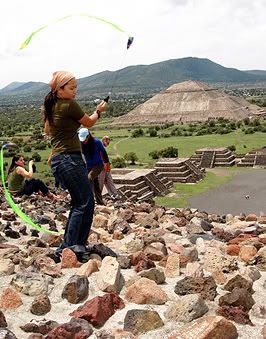I wrote an article on the art of poi, more popularly known in the country as "zipping" after the indefatigable Planet Zips team. The piece recently came out in Mabuhay Magazine, the in-flight publication of our very own Philippine Airlines.
And, as you would have to be on a PAL flight to get your hands on Mabuhay, I figured I would post a copy of it here as well in all its unedited glory.
POI-FECTLY FUN!
Has this happened to you yet? You are at your favorite beach, or maybe taking in a weekend afternoon at the park. And then a stream of bright color catches your eye. It undulates against the clear blue sky. It is joined by another. Spinning and twirling these ribbons in neon hues dance in the air. They seem almost alive, moving with the grace of a corps de ballet. Then you notice that these ribbons are being manipulated by able hands. It is also likely that the people weaving this intricate sky tango are held rapt by the movements they are creating. Chances are they’ll even be plugged into an mp3 player, totally unaware that you are watching. Or they’ll have a group of friends with them, all yelling encouraging words from the sidelines.
Congratulations, you have just seen your first set of poi, known more popularly in the Philippines as zips, after the local brand Planet Zips. The essential elements of poi are a weighted center and a piece of string. Sometimes they end with long flowing ribbons, other times with fuzzy balls or flashy LED lights. The more trained and courageous aficionados use flammable Kevlar at the end of their chains to spin fire.
These toys have sprung up all over the world. Websites devoted to the art of poi have sprung up all over cyberspace. Communities of spinners trade techniques and videos.
But this seemingly new trend has actually been around for a very long time. The Maoris of New Zealand are credited with the art of poi to help keep their arms and hands limber and their bodies coordinated. They would spin and weave as a means of expression as well as to prepare for war.
In the modern world, the art of poi is practiced as an outlet for individual creativity. Moves are strung together to create seemingly complicated combinations. The more tricks a spinner can master, the wider and richer his routine becomes. To watch a skilled spinner at work is captivating. No “show” is ever the same and no two spinners are alike. Each individual imbues their personal stamp on their style.
But why would a bit of string, a weighted center and a flowing ribbon catch the attention of so many people? Well, first of all, it is fun. It truly is as simple as that. They sometimes have a calming effect on people. Some enthusiasts are known to carry their poi with them anywhere they go, in case, as one friend once said “I need to release some stress or bad vibes.”
And if you think ribbon poi are impressive, wait until you see your first sight of fire poi in use! There is a whoosh of sound as fire poi begin to make circles in the air. To a poi fan, it is literally, the sound of energy. This harnessed power finds a conduit in the hands of the spinner as the energy flows from spinner to poi. The display, when done by someone with skill and finesse, is captivating. Coupled with the appropriate music, a fire dancing show can be mind-blowing.
Even if you don’t think spinning fire is quite up your alley, you can always pick up a pair of ribbon or LED poi and spin away. How quickly a newbie picks up the various moves depends largely on each individual. There are some who learn faster than others. Lessons help of course. You can find free tutorials on-line or buy instructional DVDs. Live classes are the most beneficial of course and there are a growing number of reputable teachers worldwide (see sidebar for lessons in the Philippines).
But when it all comes down to it, the choice is all yours. It is your choice if you would like to have structured classes or be self-teaching. It is up to you to find out what your personal style is; if you like to spin fast to house music or lose yourself in tribal beats. There are no rules or expectations. All that is expected is that you enjoy yourself.

Zipping at the Pyramid of the Moon, Mexico
Sidebar:
In the Philippines, it is the team from Planet Zips that leads the way. Created by friends who shared a passion of spinning, they re-branded the generic term poi and called their product Zips. Having picked up the art in various countries such as Japan, Mexico, Britain and South Africa, these friends are now spreading their love for zips to fellow Filipinos.
There are currently 12 core members of the Planet Zips team. They are all part of the performing group with several giving instructional classes on a weekly basis. But there are over 200 members that are involved with the art of zipping in one way or another.
For information on lessons, purchasing zips and booking Planet Zips for performances please go to: http://www.planetzips.com





0 Comments:
Post a Comment
<< Home